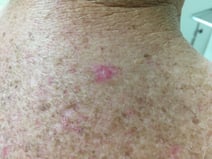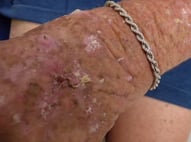What you need to know about non-melanoma skin cancers
Over 800,000 skin cancers are diagnosed in Australia each year. In fact, non-melanoma skin cancers are more commonly diagnosed than all other cancers combined. So, what are the signs and symptoms, and how do you know if you’re at risk of developing the disease?
What are non-melanoma skin cancers?
Non-melanoma skin cancer refers to cancers such as basal cell and squamous cell carcinomas. These are typically caused by sun exposure and rarely metastasise (spread) to other areas of the body. They are more common than melanoma, with basal cell carcinomas accounting for around 66 per cent of all skin cancers.
Am I at risk?
You are at increased risk for developing a non-melanoma skin cancer if you:
- are aged over 40
- have had multiple sunburns
- have pale skin, fair hair or blue eyes
- have a large number of freckles or moles
- have had skin cancer before
- have skin spots that look different to the others
- often enjoy outdoor activities or work outdoors
- bleed easily, even with little abrasion
- have ever used a tanning bed
What signs should I look for?
 Basal cell carcinomas usually appear as a lump or scaly area on parts of the body often exposed to the sun, such as the head, face, neck, shoulders and back. They often grow slowly over months or years but don't spread to other parts of the body. The small, round or flattened spots are usually red, pale or pearly in colour and can become ulcerated like a sore, bleed and fail to heal. Some spots can look like a patch of eczema.
Basal cell carcinomas usually appear as a lump or scaly area on parts of the body often exposed to the sun, such as the head, face, neck, shoulders and back. They often grow slowly over months or years but don't spread to other parts of the body. The small, round or flattened spots are usually red, pale or pearly in colour and can become ulcerated like a sore, bleed and fail to heal. Some spots can look like a patch of eczema.
 Squamous cell carcinomas grow over several months and also usually appear on areas often exposed to the sun. Typical characteristics are thick, red and scaly spots. They can be a growing, tender, firm, skin-coloured nodule. If left untreated, this form of non-melanoma skin cancer can spread to other parts of the body and become fatal.
Squamous cell carcinomas grow over several months and also usually appear on areas often exposed to the sun. Typical characteristics are thick, red and scaly spots. They can be a growing, tender, firm, skin-coloured nodule. If left untreated, this form of non-melanoma skin cancer can spread to other parts of the body and become fatal.
How can I reduce my risk?
Adopting sun safe habits is the best way to minimise your skin cancer risk. This includes daily sunscreen use and wearing a hat and sunglasses whenever you’re in the sun. Seek shade whenever possible and avoid going outside in the middle of the day.
You can’t “fix” the damage already caused by the sun, but you can monitor your skin for signs of new or changing spots which might indicate skin cancer. A head-to-toe skin check with a skilled doctor is the only way to know your skin is healthy. For your peace of mind, continue to get regular check-ups at least once a year. Ninety-nine per cent of all skin cancers are curable if found early.
